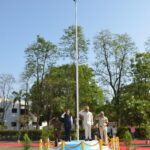
The field diary is the basic document which contains all the data collected. Facts and interpretations are to be written separately and conversations to be noted in the vernacular languages. Two kinds of field notes are to be observed
a) Taking notes on the spot
b) Writing detailed diary
Daily field diary
It is instructed to write the field diary everyday in which
a) Detailed notes of observations
b) Field notes on discussion and conversations
c) Details of Interpersonal communication, gossips, fold history’s similar events
d) Specific details of special events
Specific reference about the main field of study for instance, the details about the process of message diffusion, various kinds of channels of communication were described in detail.

Field diary for Research Process documentation
The most useful tool for a process documenter is a field diary. The documenter uses a field diary to record his or her observations and thoughts in an orderly fashion. Recording observations and impressions enables a researcher to pick up clues about how the system is operating.
A field diary should help the investigator understand the systems physical and social setting. It should help describe who, what, why, where, when and how. Who refers to the people or system being studied. What concerns the information gathered. Why, where, when and how provide important details about the observation.
There is no special format in writing a field diary but entries should be written daily in chronological order so information is not forgetten or changed because of forgetfulness. The critical concern is that observations are recorded in a diary regularly.
Diary content should be organized into two categories.
1) Observations
2) Impressions
Observations should be objective, the documenter should only write down what she/he actually saw or heard. Observations include descriptions of the physical setting (Climate, geographic area and resources), the demographics settings (concentration, movement and general characteristics of people) and the organizational setting (the different social levels in the system, the communication network and the degree of complexity in the social system).
The researcher also observes individuals, small groups, families ethmic groups, villages and government organizations. Observations can be made of situations and human actions, including actors between farmers between farmers and government agencies and between different government agencies.
The subjective impressions of the documenter make up the second category in a field diary. Impressions should be clearly differentiated from observations. If for instance the researcher observes a bitter argument between two farmers about water distribution in a canal, she/he should write down what was actually seen and then write down his or her own impressions of the vent. Impressions are important because they help the researcher evaluate and give meaning to the observations. Thus, impressions should be recorded for all observations. As a result of recording impressions, new ideas may emerge that may lead to a better understanding of the irrigation system.
| Laboratory Record |
Guidelines for Keeping a Laboratory Record
The following is a general description of how to keep a proper laboratory notebook. Requirements for different teaching, research, clinical, or industrial labs will most likely vary. Some institutions/labs will require less stringent record keeping, others will hold you to a very strict protocol. A well kept notebook provides a reliable reference for writing up materials and methods and results for a study. It is a legally valid record that preserves your rights or those of an employer or academic investigator to your discoveries. A comprehensive notebook permits one to reproduce any part of a methodology completely and accurately.
Choosing a notebook
For most purposes you may select a bound notebook, quadrille-ruled. A teaching lab may require tear-out duplicate pages for making carbon copies. An engineering or industrial research/development lab will likely require a specific type notebook with prenumbered pages and places for date and investigator’s and supervisor’s signatures on each page. Pads of tear-out graph paper or spiral bound notebooks without pre numbered pages are not acceptable. It must be impossible to tear out a page without leaving evidence. It is safest to select something that is clearly labeled as a laboratory notebook.
Preparing the Notebook
Please use a ball point pen for all entries, so that the marks will not smear nor will they be erasable. Put your name, a telephone number and/or address, and project name or course number on the outside front cover of the record. Put that same information on the first page inside, or on the inside front cover. If your notebook does not include a prelabeled table of contents section, then reserve the next several pages for a table of contents by labeling the top of each page as Table of Contents and numbering each page. If your notebook does not have prenumbered pages, you may wish to use lower case Roman numerals, as in a standard publication. Next, number the next several pages with Arabic numerals in sequence, and you are ready to begin recording data.








Leave a Reply